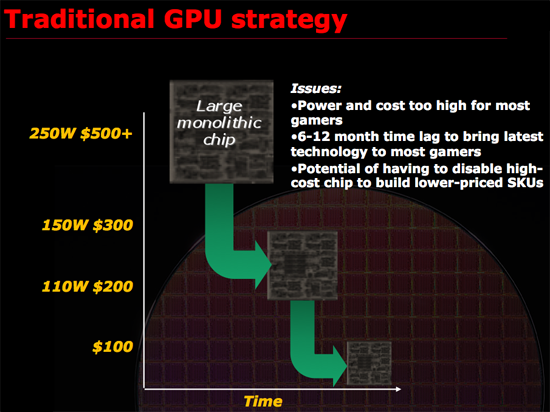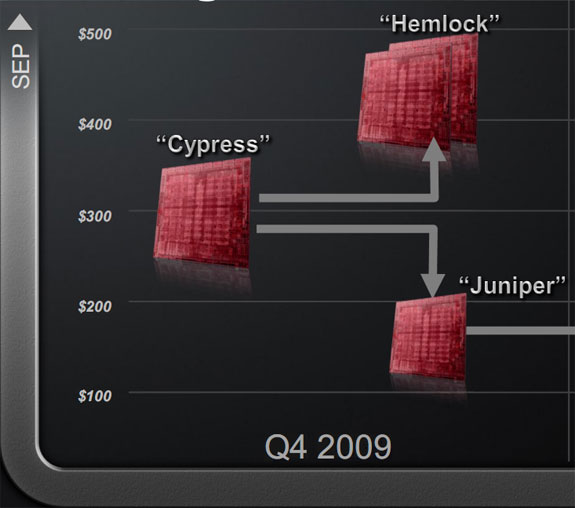The RV870 Story: AMD Showing up to the Fight
by Anand Lal Shimpi on February 14, 2010 12:00 AM EST- Posted in
- GPUs
What Made it All Ok: 4 GPUs in < 6 Months
Through a lot of hard work and sacrifice, even on Carrell’s part, ATI cut the RV870 from as much as 22mm on a side down to roughly 18mm x 18mm. The problem is that RV770 was around 16mm on a side. The RV870 was still too big.
Carrell wanted to cut it down even more, but two things changed his mind. First, in order to build 870 in the space of a 770 ATI would have to cut out much more from the chip than Carrell originally tought. One of the things that would have to go was some of the shader core.
In order to run the GDDR5 memory at the sort of data rates that ATI was targeting for the 5870 the analog PHYs on the chip had to grow considerably. At 16mm on a side ATI would either have to scale back memory bandwidth or eat into the shader core area. Either way we would’ve had a slower chip.
I asked Carrell if 16mm on a side would’ve made the RV870 $100 cheaper at launch, putting it on par with the RV770 launch prices. He said no. I didn’t find out why until much later, but I’ll save that story for another time.
Sacrificing performance to meet the 16mm x 16mm die size targets wasn’t going to happen, but what ultimately convinced Carrell to go with a larger die this time around was something that ATI didn’t get nearly enough praise for: the ability to launch 4 different 40nm DirectX 11 GPUs in less than 6 months.
Remember that Carrell’s beef with building the biggest GPU possible is that it takes too long for the majority of customers to get access to derivatives of that GPU. Look at how long it took G80 or GT200 to scale down. And who knows when we’ll see $150 Fermi/GF100 derivatives.

But ATI Engineering promised two things. First, that Cypress would have a successor called Juniper that would be ready around the same time. Secondly, two more GPUs would follow and the whole stack will be done and out in less than 6 months. ATI came close in 2008 with 3 GPUs in 3 months, but the fourth member of the 4000 series didn’t show up until April of 2009.
It wasn’t an impossible feat. ATI does have concurrent design teams and a lot of engineering resources in India/China. By working on Juniper in tandem with Cypress, assuming there were no show stopping bugs, ATI could exploit efficiencies in two teams effectively working on the same hardware (Juniper was just half a Cypress).
The idea of taking such a huge risk made Carrell uncomfortable. Running two GPU designs in parallel, for the same family of chips, is risky. If everything works out perfectly, you get two chips out at the same time. If it doesn’t, you’ve just tied up two design teams on one product generation. A slip here would give ATI its own Fermi.
What ultimately sold Carrell was the fact that engineering told him that they believed they could pull it off. Carrell believes in people. He believes if you expect the best out of those around you, then that’s what you’ll get. He couldn’t reconcile his beliefs with doubting the schedule engineering was feeding him. Carrell nervously signed off and the Evergreen stack was born.

Cypress and Juniper were delivered nearly at the same time. In fact, Juniper was ready a bit earlier and was sampled to developers months before ATI launched the 5000 series. Cedar and Redwood followed, not to mention a dual-Cypress board that became the Radeon HD 5970. And all of this was done and ready in less than 6 months (the chips themselves were all ready within 4 months).
When the smoke cleared ATI had new DirectX 11 parts at $600, $400, $300, $200, $150, $100 and $60. The Windows 7/DirectX 11 market bulge just got serviced.










132 Comments
View All Comments
n7 - Sunday, February 14, 2010 - link
Another great story told.Thanx, Anand.
MrK6 - Sunday, February 14, 2010 - link
What a great piece. Thank you for taking the time to put this together; it's one of the best tech articles I've read.archcommus - Sunday, February 14, 2010 - link
Haven't even read the whole thing yet but I can already say this is excellent. Thank you, Anand.indicator - Sunday, February 14, 2010 - link
Hi allI felt I had to register here after reading this article , what a fantastic insight into everything that goes into making these GPU's and the dedication and talent it takes to be so creative.
Great to see Anands enthusiasm for the industry come across in the article too
I've been coming here and reading Anandtech since around the mid ninties I guess , it is a superb source of information , I look forward to every new article/review posted.
Keep it up guys
Lee
(uk)
d3x7r0 - Sunday, February 14, 2010 - link
Very very good article as usual in this website. AnandTech has been one of my favourite sites in the area for so long I don't even remember how I found out about the website, I actually believe I was still in 56k when I first came here.Anyway reading this article made me speculate on something (and please correct me if I'm wrong): If I got the timings right AMD-ATI should be working on the Northern Islands since the Radeon HD4xxx series days so the same issues they had with the HD5xxx series would be in the past. If this is true it means they know the HD4xxx were a success from the beginning of the process (or near it) and as such I can't but help it be even more excited to see what the next generation of ATI cards has in store.
It's such a good time to be an ATI fan it's not even funny :D
Atlantis6000bc - Sunday, February 14, 2010 - link
Those kind of article are the prime reason why I keep coming back to Anand....keep 'em comingThe13thWizard - Sunday, February 14, 2010 - link
Thanks Anand! Thats the best IT article Ive ever read! Very toughtfull and interesting!arnavvdesai - Sunday, February 14, 2010 - link
Really helps understand the industry a lot more. I really wish AMD would take a cue from its graphics division and really start hammering out what kind of chips do they want to build. However, they have their own set of challenges as Intel unlike NVIDIA is really really good on the foundry side as well.However, with gaming becoming more and more centered on consoles, does ATi have something cooking for the next generation of consoles? Would love Anand to ask them something about that. Do they believe that they will continue to sell enough cards to continue recouping their costs of designing and manufacturing them.
Vishnu Narayanan S - Sunday, February 14, 2010 - link
First of all, hats off to you for this amazing article.... Its these articles that bind us to the Anandtech website for years and years.I sincerely hope and request you to provide similar in-depth and "behind the scenes" stories from NVIDIA and Intel. Just to satisfy the FANbois... lol
fausto412 - Sunday, February 14, 2010 - link
once i started reading i couldn't stop. for a geek like me this was almost like sex:) keep them coming!